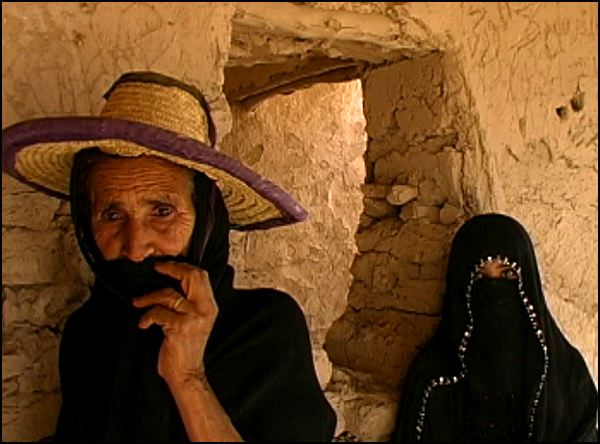
©ViewZone Expedition 2001
|
Marib, despite it's unassuming appearance,
held many treasures for those with the correct guide. And we had Ahmed.
Over dunes, past farms, through small villages, past the Bedouin's shanty town... no matter where we looked there was breathtaking scenery. With the attention to detail given to buildings (especially windows), the bright colors of shepherd's wraps, and the ever changing sunlight on the sprawling desert, it was impossible to take a bad picture. Yet, for all the beauty, there was something for more than the eyes; something the soul could appreciate. Yemen holds a spell that is both mesmerizing and sobering. This harsh environment has produced some of the most delicate art and intricate philosophies of human history. Ahmed kept us well informed of where we were and what we were looking at, from the distant mountains to the flowers in the fields we passed. In the evenings, after dinner, Ahmed often took a book to bed with him. In the mornings, he would emerge full of knowledge and enthusiasm. For Marib, there must've been an awful lot of reading to be done.
Old Marib was a ghost town in the desert. A clear view of the entire valley could be easily gained by climbing up the slick rounded steps of the aged and abandoned buildings to the mud penthouses. From above, looking down on the coffee colored town, I could see the movement of sheep and children in the rubble below.
Old Marib had a desolate kind of beauty. The crumbling skeletal walls were almost completely destroyed by bombs that fell in 1964. During the liberation from the Imam by Egyptian forces, artillery shells ripped through rooftops and walls, leaving behind hideous sky-lights and open-air kitchens.
We assumed that the village was abandoned. We were wrong. From our eagle's eye view we saw children and mothers moving along paths in the rubble. In the distance, a shepherd-boy herded his goats along a dried stream bed. A man in a thin t-shirts peered down at us from one of the old, ornately carved windows. I waved and smiled. He waved and smiled back.
We explored the town until the sun set, and then returned to our oasis at the Bilquis Hotel, dusty but happy.
|
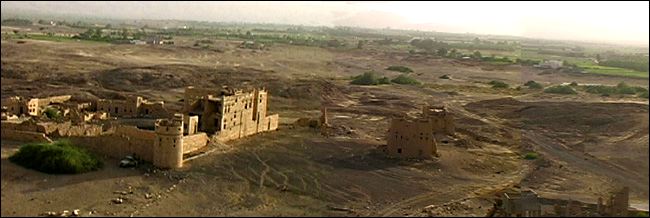
Surviving thousands of years of weathering and erosion, Old Marib's fortified walls (above) could not withstand the artillery shells of modern tank warfare. Damage inflicted during the liberation from the Imam (in the early 1960's) turned many of these ancient mud buildings to rubble.
The Bar'an Temple 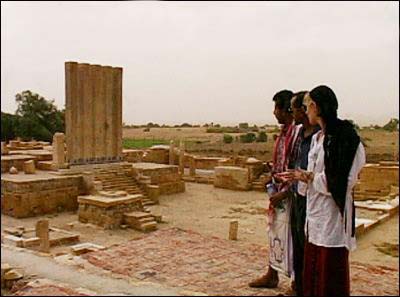
Research on this location produced a string of names. Known as the Bar'an Temple, the Almaqah Temple, The Moon Temple, the Al-Amaid, and also as Arsh Bilquis, "Throne of Bilquis", this site was more than a road-side attraction. It was a fascinating place.
In recent years, extensive work has been done by international archeologists to unearth the walls, floors and altars of this mysterious temple. Most of it was now above the earth for our inspection. Here were the clues left by the past cultures who lived on this land. Here was the mystery of a once lush and powerful civilization mentioned in the Bible and forgotten by time. The answers were all here in these ancient ruins.
Our inspection began on a broad stone platform overlooking the interior of the temple. Nasser took the role of interpreter, and soon we were learning all about this Sabaean house of worship.
|
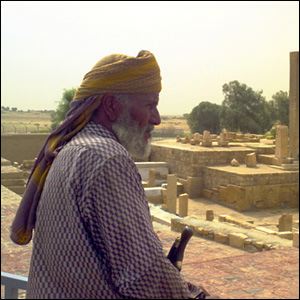
|
The temple was built in two major phases. The first construction has been dated to between the 2nd millennium and the 1st millennium B.C. The second phase, on the same foundation, started in 850 B.C. and was restored again in 4th century A.D.
Exploring the back of the site, we ran across some disembodied pieces of the temple, ready to be transported to universities for study. Sitting so close to the ruins, all stacked on the sand, we could examine the workmanship of the ancient masons. At the center of the temple, five huge, rectangular columns pointed to the sky. A sixth monolith was broken. Pieces from this column were standing at the center of the temple. It was possible to see how they were made in sections and then carefully pieced together. But how, I thought, was this done with no cement or mortar? Each completed column was 17 tons in weight, 12 m in height and 80 x 60 cm thick. antiquity in this place. |
|
Water basins were filled from the stone mouths of delicately carved bull's heads which once flanked the steps to the altar. This well designed structure was very functional. Imprints in the stone floor marked the spot for the bull's hoofs. A stone structure stood ready to hold the severed head, offered up to the Moon God. Grooved canals drained the sacrificial blood to distant collection bowls. Stone inscriptions, in the Sabaean style, were carved on the altar and devotional plaques. The Marib Dams |
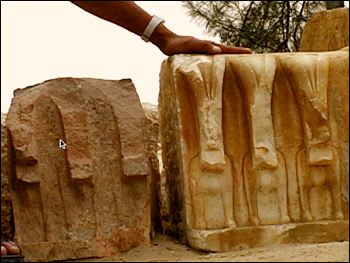
|
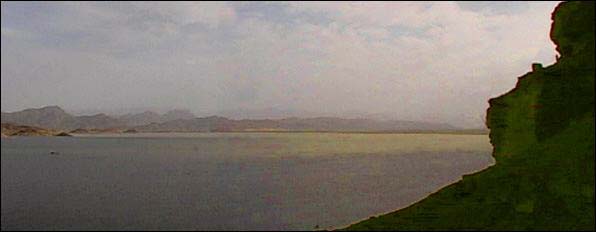 The new Marib Dam (above) provides for an abundance of water.
The New Dam
The new Marib Dam was started in 1984 and completed in 1986. It was a gift worth 75 million dollars from Sheik Zaid bin Sultan of the United Arab Emerates. The Sheik was a descendant of the Sabaeans, the people who built the original dam 3000 years earlier. The original dam did not produce a large reservoir. It slowed the flow of the water and channeled it through two main irrigation routes, known as the East and West Gardens. By contrast, the new dam causes the flow of water to gather in a large reservoir where it eventually finds its way to Yemen's aquifer. Sheik Zaid bin-Sultan's gift literally gave life to Yemen's people.
The new dam wall is 180 feet (55 meters) deep and is constructed with waterproof concrete and reinforced with iron. The dam is 2,297 feet (700 meters) long and holds back about 14,126 million cubic feet (400 million cubic meters) of rain water.
The Old Dam
All of this lush vegetation was destroyed in 100 B.C., and A.D. 370, 449, 450, 542, and finally in 570. The flood of 570 remained unrepaired and permanently changed the landscape of Marib.
The old dams were subject to infestation by rodents. The walls were made from mud and straw which the rats found very yummy. Cats were tethered with strings every few yards to stop the rodents from eating the walls. This low-tech solution was vital to the maintenance of the dam. It was neglect of such things that allowed the dam to deteriorate and rupture throughout its history.
There is recent evidence that the Marib Dam's final demise may have originated far away in what is now Java. A large volcano exploded there in 535 A.D. and ejected an unparalelled amount of debris into Earth's upper atmosphere, changing the climate around the globe for many decades. Yemen would have been subjected to many years of drought, followed by intense flooding from the onset of heavy and unending rain. The strain on the weakened dam would have surely caused it to break beyond repair. (See Catastrophe! by David Keys)
Marib was like a time machine in the sands. In one day I had run along the walls of an ancient dam, I had followed the paths once frequented by the Queen of Sheba, and I had stood on the rooftop of an age-old, mud high-rise. Our modern slice of Marib came from the comforts in our spacious and gracious Bilquis Hotel.
"Get some sleep," Ahmed told us, our last night in Marib, "We're leaving at four a.m. to go to the desert."
We thought he was kidding.
He wasn't.
|
<--Previous Page || ViewZone || Next-->
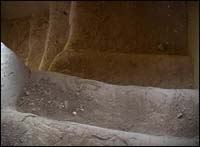
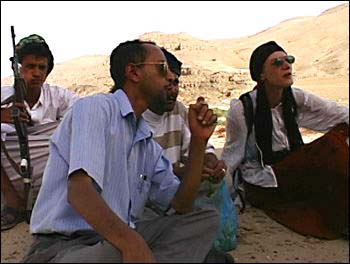 At the site of the legendary Marib Dams, we climbed over huge sand dunes and marveled at the engineering accomplishments. We could clearly see the Old Dam, designed primarily as a series of sluices, while we inspected the New Dam and the large pool of sparkling water that it held back in the dry desert.
At the site of the legendary Marib Dams, we climbed over huge sand dunes and marveled at the engineering accomplishments. We could clearly see the Old Dam, designed primarily as a series of sluices, while we inspected the New Dam and the large pool of sparkling water that it held back in the dry desert.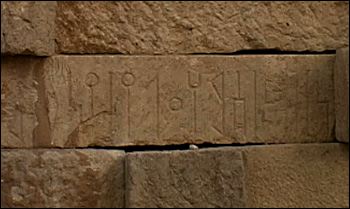 We were told the tale of the gardens that once grew in Marib. Legend and scriptures speak of trees so full of ripe fruit that, if one were to walk through these gardens with a basket on one's head, the basket would be full of ripe fruit by the time the trip was finished.
We were told the tale of the gardens that once grew in Marib. Legend and scriptures speak of trees so full of ripe fruit that, if one were to walk through these gardens with a basket on one's head, the basket would be full of ripe fruit by the time the trip was finished.